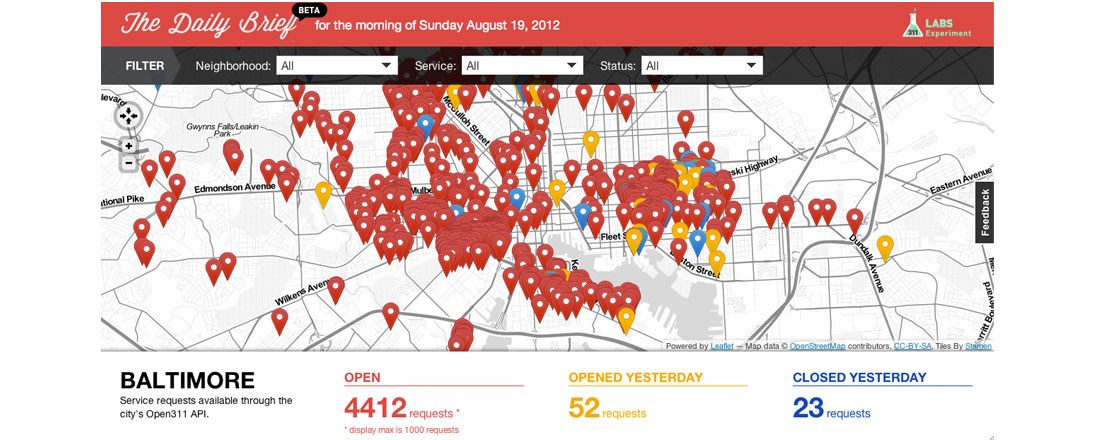Baltimore has become a testing ground for a nascent citizen request initiative, the Daily Brief.
Displayed on an online map are Baltimore’s 311 requests, color-coded according to total open cases, cases opened yesterday and cases closed yesterday. All requests can be filtered by neighborhood and service, like downed power lines.
The Daily Brief itself is a product of 311 Labs, launched in July by Code for America, the nonprofit organization founded in 2009 that recruits plucky young designers, developers and engineers and places them in year-long fellowships in cities around the country.
The goal? Use technology and civic data in collaboration with municipal offices to make city government more responsive and effective. (The idea isn’t so farfetched. Mark Headd, formerly Code for America’s director of government relations, just became the first chief digital officer for Philadelphia.)
In 1996, Baltimore became the first U.S. city to introduce the 311 phone number for residents to report non-emergency situations: potholes in the street, graffiti in an alleyway, downed power lines and the like.
Last August the city introduced its 311 smart phone app, handing residents the ability to punch in service requests accompanied by on-the-street photos from their iOS- and Android-powered devices. At the time, Mayor Stephanie Rawlings-Blake hailed the app as something that gave Baltimoreans “real-time collaboration with their government.”
Download the iOS or Android version of Baltimore’s 311 app.
The one issue, naturally, is creating a means by which residents outside of government can send and receive information to and from city-government databases.
As of 2009, that matter was solved with Open311 implementation. In short, Open311 is a web API for “writing and reading civic data directly to and from city systems,” as Code for America’s Jesse Bounds writes. Initially developed concurrently in San Francisco and Washington, D.C., Open311 works when a city’s database system—in this case, the 311 system—is overlaid with the Open311 API, effectively enabling residents to see individual database references (individual sightings of downed power lines, for instance) and insert new information.
“It’s like a big spreadsheet in the sky,” says Bounds, a 35-year-old Code for America fellow based in Chicago.
And that’s the way Baltimore’s mobile 311 app and Code for America’s Daily Brief map work.
Bounds and Code for America compatriot Angel Kittiyachavalit, a 25-year-old UI designer also based in Chicago, describe 311 Labs as an online laboratory for experimenting with cities’ 311 data. Another initiative through 311 Labs, Open311 Status, allows people to check whether Open311 APIs in cities nationwide are working.
“We thought 311 Labs was a way for people to … see what to do with the Open311 data,” Kittiyachavalit says. “We want people to play with the data and try to show the data in different ways.”
One such way is that Daily Brief map, available currently in only Boston, Bloomington, Indiana and Baltimore, a situation that was more “happenstance” than anything else, says Bounds. Right now, Bounds and Kittiyachavalit are two members of a four-person team working on Open311 API implementation in Chicago, the ultimate goal being to introduce an Open311 API and then build accompanying applications similar to Baltimore’s 311 mobile app.
“Turns out creating Open311 API in these cities that didn’t have them has been difficult and complex,” Bounds says.
The trade-off, however, came when Bounds and crew began trying out an early form of its Daily Brief mapping system. Evidently Baltimore and Boston use the same 311 system vendor as Chicago for their call centers and Open311 APIs. Concluding that if the Daily Brief map worked with Baltimore and Boston it would also work once Chicago’s Open311 API implementation was completed, the Chicago Code for America fellows charged ahead. (The real outlier is Bloomington, which, says Bounds, doesn’t use a vendor for its Open311 system—the town employs developers instead—but they wanted a small town to draw comparisons against.)
Of course, placing data as geographical points on a map is about as trendy right now as Carly Rae Jepsen asking you to maybe call her. But one advantage, Kittiyachavalit says, is the ability to “see clusters of problems together,” which might inform city officials that five potholes on one particular street means it’s time for a repaving job.
“Having data on a map is interesting, but it’s not the be all and end all,” Bounds says. Right now the Chicago fellows are working on an updated version of the Daily Brief that allows user queries to be processed, and a forthcoming tool from 311 Labs—the 311 Dashboard—will allow people to view 311 data as points on a map or as rows in a spreadsheet.
“The map is like 10 percent of the overall picture in my mind in terms of how the data can be used and how it can be visualized,” says Bounds.
Join the conversation!
Find news, events, jobs and people who share your interests on Technical.ly's open community Slack

Baltimore daily roundup: Medtech made in Baltimore; Sen. Sanders visits Morgan State; Humane Ai review debate

Baltimore daily roundup: The city's new esports lab; a conference in Wilmington; GBC reports $4B of economic activity

Baltimore daily roundup: Find your next coworking space; sea turtle legislation; Dali raided and sued

